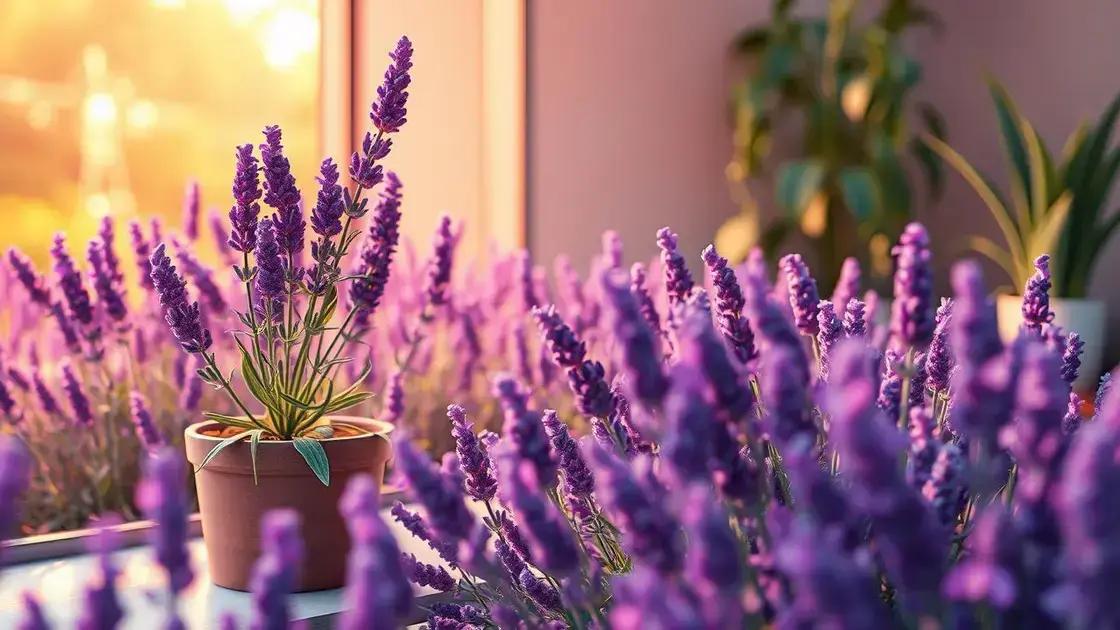How to Care for an Indoor Lavender Plant: 7 Essential Tips for Success
How to care for an indoor lavender plant effectively requires understanding its unique needs. This charming herb not only beautifies your space, but it also brings a soothing aroma and vibrant color to your home. As we dive deeper, you’ll discover practical tips that will keep your lavender thriving indoors.
Table of Contents
ToggleEssential sunlight exposure for indoor lavender
Essential sunlight exposure for indoor lavender is crucial for promoting healthy growth and vibrant blooms. Indoor lavender plants thrive best when they receive adequate sunlight, mimicking their natural environment. To ensure your lavender flourishes indoors, consider the following guidelines:
Optimal sunlight conditions
- Lavender requires a minimum of 6-8 hours of direct sunlight daily.
- Placing the plant near a south-facing window is ideal, as it allows maximum light exposure.
- If natural light is limited, consider using grow lights to supplement sunlight, particularly during shorter days.
Signs of insufficient sunlight
- Weak, leggy growth and elongated stems.
- Pale or yellowing leaves.
- Reduced blooming or fewer flowers overall.
Adjusting light intensity
When introducing new lavender plants to sunlight, it’s important to acclimate them gradually, especially if they were previously indoors with little light. Here’s how to make the transition:
- Start with 2-3 hours of direct sunlight, increasing exposure gradually over a week.
- Monitor leaf health for signs of scorch or browning; adjust exposure accordingly.
For those interested in improving their indoor gardening skills, consider exploring indoor gardening techniques. Learning about light needs, soil, and overall care can elevate your experience and ensure successful plant growth.
Conclusion
Understanding the essential sunlight exposure for your indoor lavender plant is vital for its well-being. By ensuring it receives ample light and observing its growth, you can cultivate a thriving lavender that adds beauty and fragrance to your home.
Optimal watering schedule for your lavender plant

Optimal watering schedule for your lavender plant is key to ensuring its health and longevity. Lavender is a drought-resistant plant, which means too much water can harm it. Understanding how often to water your lavender will help you maintain its optimal growth.
Understanding lavender watering needs
- Lavender prefers to dry out between watering sessions.
- Check the top inch of soil; if it feels dry, it’s time to water.
- During growing seasons (spring and summer), watering once a week is generally sufficient; adjust according to humidity and temperature.
Signs of overwatering
- Yellowing leaves, which may indicate root rot.
- Mushy stems or a foul smell from the soil.
- Leaves dropping off prematurely.
Watering tips for success
To ensure your watering strategies are effective:
- Use well-draining soil to prevent waterlogging.
- Consider using pots with drainage holes to allow excess water to escape.
- Water at the base of the plant to minimize wetting the leaves, which can lead to fungal issues.
For further insights on better gardening practices, you can start exploring indoor gardening techniques. Learning from various sources can enrich your understanding of how to care for indoor plants like lavender.
Conclusion
By following an optimal watering schedule for your lavender plant, you can achieve a flourishing and aromatic indoor garden that enhances your living space.
Understanding soil requirements for healthy lavender
Understanding soil requirements for healthy lavender is essential for cultivating a thriving indoor plant. The right soil composition supports lavender’s unique needs, ensuring it remains healthy and vibrant. Here’s what you need to know.
Ideal soil composition for lavender
- Lavender thrives in well-draining, sandy soil.
- A mix of sandy loam, perlite, and compost works well, providing both drainage and nutrients.
- A pH level between 6.5 and 7.5 is optimal for lavender’s growth.
Soil drainage importance
Proper drainage is crucial to prevent root rot and ensure healthy growth. Here are some key methods to enhance soil drainage:
- Use pots with holes to allow excess water to escape.
- Incorporate gravel or sand into the soil mix to improve drainage.
- Avoid heavy, compact soils that retain too much moisture.
Signs of incompatible soil
- Yellow leaves can indicate poor root health due to lack of drainage.
- Stunted growth often results from nutrient imbalance or weighty soil mixtures.
- Roots may rot if the soil remains waterlogged.
For a deeper dive, consider exploring indoor gardening techniques. Understanding different soil types will help you make informed choices for your lavender plants.
Conclusion
Undoubtedly, understanding soil requirements for healthy lavender is vital for successful growth. By choosing the right soil and maintaining proper conditions, you will nurture beautiful indoor lavender plants.
In conclusion
Caring for an indoor lavender plant successfully requires a combination of understanding its needs, including optimal sunlight, watering schedules, and soil requirements. By ensuring your lavender receives adequate light, is watered appropriately, and planted in well-draining soil, you can enjoy a thriving and beautiful indoor garden. For additional tips on enhancing your indoor garden, consider exploring various resources that offer practical advice and insights.

